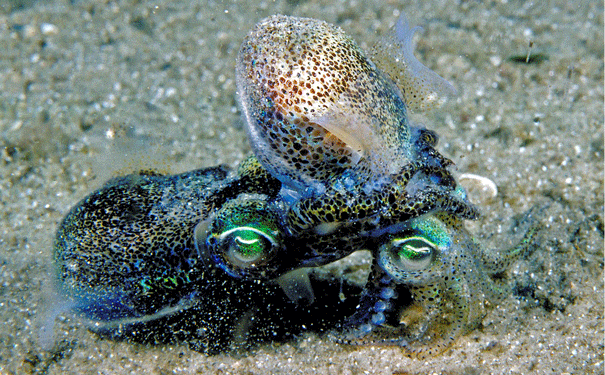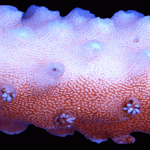
The energetic cost of mating for a promiscuous cephalopod can be huge. Image: Mark Norman
The dumpling squid (Euprymna tasmanica) mates for up to three hours and cannot return to peak physical form for up to 30 minutes.
This cephalopod is named for its bulbous shape; they are short-lived, seeing only their one-year birthday at the most. In that time, they are known for spending months toward the end of their lives mating with as many other squid as possible, and it seems to be physically taxing.
“Investigations into mating costs can provide insight into the evolution of reproductive strategies,” says lead researcher Amanda Franklin at the University of Melbourne. “We wanted to see whether the energetic cost is small, like traditionally assumed, or whether it may have important implications for species with long, very active or frequent copulations.” According to researchers, costs that individuals acquire through mating play an important role in understanding the evolution of life.
To test this concept, the marine animals were captured through night SCUBA dives in Port Phillip Bay, Victoria. In the lab, endurance was tested by prompting the cephalopods to move against a constant current in a chamber until they wouldn’t swim any more. The researchers did this before, immediately after and 30 minutes after mating and compared the three endurances. They also had a control group to ensure the result was from copulation and not from being tired from the first swim.
“We found that squid could only swim for half as long after mating and that they took up to 30 minutes to recover their swimming endurance,” says Franklin. “This could affect the squid’s ability to escape predators, forage for food, and could also reduce their ability to seek out other mates.”
During mating, the male initiates contact by grabbing the female and holding her the entire period of copulation. Males are energetic during the process, squirting ink and pumping streams of water into the female’s body. Though females are less active during the act, researchers theorise that in being held down, males cut off females’ access to oxygen.
These results aren’t only relevant to cephalopods. Franklin believes their outcomes are applicable to many other species that also have long copulations (e.g. damselflies), active copulations (e.g. African lions) or mate multiple times within a short period (e.g. antechinus). “It is likely that these animals will also experience an energetic cost, which will affect their physical capabilities after mating,” she says.
The scientists will continue to research reproductive behaviour and are also working on understanding the benefits to female dumpling squid of mating with more than one male.






